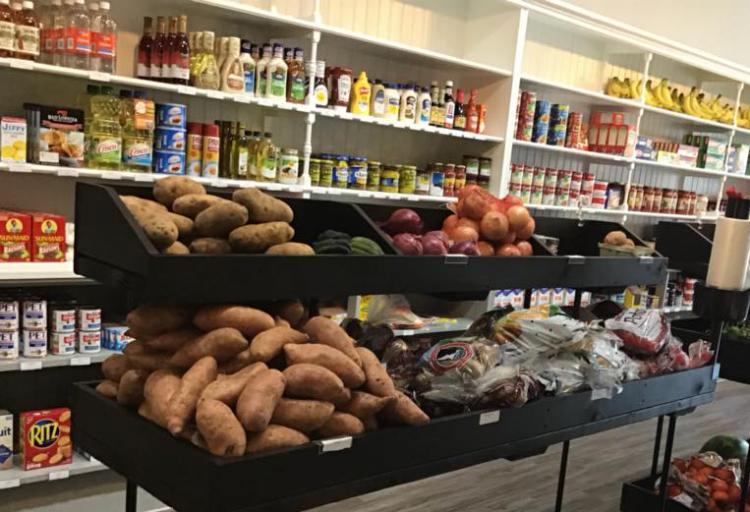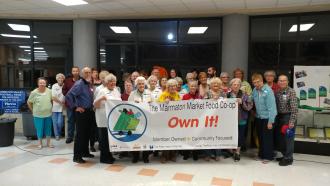Co-ops in Rural America


It is hard to avoid the irony that huge portions of rural America—our so-called breadbasket—are considered food deserts. Surrounded by huge fields of corn, soybeans, wheat, cotton, and other commodity crops, communities are losing their local grocery stores—and ready access to healthy food.
Where once there were small, independent grocery stores in almost every rural community, they are now closing at a dramatic rate. Private owners are being pushed out of business by big box stores, even when they may be 10 or 20 miles down the road. When these owners retire, it can be almost impossible to find anyone interested in taking over the business. For example, in Kansas nearly 1 in 5 grocery stores in communities with population under 2,500 went out of business between 2008 and 2016. And Kansas is not alone.
Declining rural populations may seem like the obvious culprit, but the evidence does not support this. Clearly, competition from big box stores like Walmart has led to the closure of many grocery stores and other rural businesses. These large stores offer low prices and draw customers from long distances, leaving smaller local stores to survive on convenience purchases.
But limited-assortment stores such as Dollar General are also having a huge impact. Dollar General, Family Dollar, and Dollar Tree have over 25,000 locations in the U.S., and these companies plan to open over 1,000 new stores per year. These stores are now within five miles of perhaps 75 percent of the U.S. population, heavily weighted toward those areas where there is no other food outlet with 10 miles. While providing access to popular household supplies and non-perishable grocery items, most of these stores offer limited or no produce, meat and other perishables.
This is not an easy environment in which to establish viable food co-ops.
Survival resources
In addition to the inevitably higher costs of operating a small business, independent grocers also face distribution issues and a lack of support networks. The good news is that both research and specialized support for rural grocery stores has been expanding, and promising models are emerging.
Independent grocery stores have found that they can survive in a small town, even with a “Dollar” store nearby, by emphasizing personal service and providing the goods and services that their competitors neglect. Quality produce, prepared foods, and meat departments become focal points and earn customer loyalty. These store operators recognize that people will travel to the nearest big box store or the local Dollar store for household products, pet food, and other basics, so they minimize their inventory where they cannot compete and invest in other things their customers want.
At a recent Rural Grocery Summit in Manhattan, Kansas, store operators spoke with pride about their in-house butchers and custom meat products, deli services, and connections to their community. While most small rural grocery stores offer a conventional product mix, many also offer a modest assortment of natural/organic and local food choices.
In very small, isolated rural communities, local grocery stores benefit from the inconvenience to customers of driving 20-40 miles to the nearest market and can earn loyalty even when prices and selection are less desirable than those distant competitors.
Co-ops have much in common with these independent operators, including a focus on meeting community needs and an emphasis on quality and service. Co-ops should be a good fit for communities that have lost or are losing their local grocery store, but until recently there had been few attempts to use the co-op model.
Store closing: co-op opening
Over the last several years, cooperative development centers have begun paying more attention to these opportunities, with promising results. The organizing process often looks very different from the more common natural food co-ops in larger communities.
Because the motivation to start a co-op arises from the loss or the imminent closure of a store, the new co-op frequently has the opportunity to acquire an already outfitted grocery store. However, this creates great pressure to proceed quickly to meet the current owner’s timeline. Rather than the 3-7 years that most startups need, a project like this may be completed in a one or two years. Community members are readily recruited as owners once the opportunity is explained and the importance of preserving an important contributor to their quality of life becomes apparent.
However, low populations equate to low ownership totals, even though 100 shares may represent a significant percentage of the town’s households.
Fortunately, the capital needed to take over a small-town grocery store is far less than the cost of a typical, larger startup. Owner equity, seller financing, bank loans, and occasional grants are common funding sources in these small-town scenarios. For the co-op to be viable in an area with relatively few potential customers, debt and expenses must be kept to a bare minimum.
Even though acquisition of a store can be done quickly, there are many potential problems that a new co-op may need to address. Many rural stores have older equipment and deferred maintenance issues that need attention. Refrigeration and HVAC systems may be old and inefficient, and inventory may include unsaleable stock and short-dated products. In some cases, the previous owner’s employees may want to stay on—otherwise, the co-op will need to find a qualified manager and staff.
Here are the stories of two new co-ops in rural America. Marmaton Market bought and took over an existing grocery store, and Great Scott! Community Market started from scratch.
Marmaton Market
In Moran, Kansas (population 558,) people decided to take matters into their own hands. The local, independently-owned Stubs Market had been up for sale for some time, but no buyer had come forward. There was a real possibility that the store would be shuttered. Stubs was the only grocery store in Moran and the primary outlet for other small towns in Allen County.
Thrive Allen County—a local nonprofit that supports rural revitalization, focusing on quality of life—recognized the importance of a viable grocery store. It spearheaded the effort to form a cooperative to buy out Stubs Market. Yvonne Scott was working through Thrive Allen County as a Vista volunteer and had previous experience with food co-ops. She became the co-op’s enthusiastic and highly effective project manager.
Scott contacted Food Co-op Initiative to outline the opportunity and find out if it could be viable. The store would need a lot of cleaning and updates, including most of its refrigeration equipment. Not to be intimidated, she pushed ahead, and FCI helped the co-op get incorporated and begin recruiting owners. FCI also awarded Marmaton Market one of its $10,000 Seed Grants and visited the town to promote the co-op concept and answer questions from organizers and the community.
Having a paid professional leading the organizing effort and the backing of Thrive Allen County made it possible for the co-op to come together in record time. This was important, since Stub’s owners were anxious to be rid of it. Within a year, the co-op had signed up a hundred owners, completed its business plan, and secured financing. In January of this year, the co-op hired Rachel McDonald to be their general manager—a major milestone and with the great good fortune that she came to the position with years of co-op grocery experience at the Ozark Co-op.
Timelines are always tricky. But conversions of existing grocery stores to food co-ops are especially difficult, because the sellers’ needs rarely align with the co-op’s needs. Co-op development does not happen overnight, and even with the remarkably quick progress that Marmaton made, they were pressured to close the sale before all their capital had been released by their primary lender.
Nonetheless, on May 30, 2018, the co-op took possession of the store and proudly announced: We own it! The store is open, and there are changes every day. Please be patient!
Without even interrupting business, the co-op began selling groceries, deep cleaning, and making improvements. But problems began mounting just as quickly. Without access to all their loan funds, the co-op was not able to invest the required equity to join AWG, their cooperative distributor.
For over a month the co-op relied on smaller local distributors and even restaurant suppliers. Some of the inventory inherited from the previous owners was going out of date, and the co-op could not fully restock the store. Coolers and compressors started failing. The co-op had known they would require replacement, but losing most of their refrigerated display space in the first three weeks was not part of the plan.
When the loan money finally came through, Marmaton Market was able to join the AWG distribution cooperative and begin getting regular deliveries. AWG is also working with Marmaton Market on a contract to replace its refrigeration equipment.
Not surprisingly, sales have not yet reached the levels projected for the store to remain successful. But McDonald is confident that as they continue to implement upgrades and improvements, the community will respond. The co-op is seeing new faces, and people who were skeptical about its chances for success are recognizing the changes and becoming believers.
Great Scott! Community Market
After three successive owners failed to keep the local grocery store open, residents of Winchester, Illionois (population 1,500), had only a Dollar store in town and a half-hour drive to Jacksonville to get fresh foods. In March of 2017, community leaders called a public meeting to discuss how they could improve their grocery access and invited Sean Park from the Illinois Cooperative Development Center (ICDC) to talk about a co-op option. In addition to leading the ICDC, Sean had personal experience running a rural grocery store and was able to help organizers plan for a store that would meet their needs while still being affordable.
In Winchester, dry goods and frozen food were available at low prices at the Dollar store, and a popular local meat market existed, but produce and prepared foods were not offered anywhere in town. The co-op planned a small store that emphasized produce, perishables, and deli sales, and located next door to the meat market. Financial projections showed that the store could be viable with only $270,000 in annual sales and would require $80-$100,000 in startup capital. Using lots of local labor—some donated, some at discounted rates—the co-op built out 1,000 square feet of retail space, bought new self-contained refrigerated cases, had custom shelving made, and acquired an inexpensive POS system. They opened a doorway between the co-op and the meat market for customer convenience and increased foot traffic.
On August 25, 2018, Great Scott! Community Market opened for business with 120 owners. They employ a full-time manager and six part-time staff, many of whom only work one or two shifts per week. Even with limited cooking equipment, the deli is responsible for about a third of the store’s sales. •
Editor’s note: Free webinars on rural co-op development will be broadcast in November and December, 2018, sponsored by the Association of Cooperative Educators (with additional funding from CHS Foundation). Learn more at info@ace.coop.







